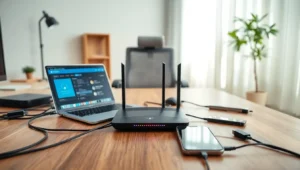In today’s digital age, a stable internet connection is like oxygen—absolutely essential and often taken for granted. But when that connection decides to play hide and seek, frustration levels can skyrocket faster than a cat video going viral. Whether it’s buffering during the latest episode of a binge-worthy series or a dropped Zoom call right before the big presentation, internet hiccups can turn anyone into a modern-day Grinch.
Imagine trying to stream your favorite show only to be greeted by the dreaded buffering wheel. It’s enough to make even the calmest individual consider a career in meditation. Understanding the common culprits behind these pesky internet connection issues can save the day, ensuring smooth browsing and streaming. Buckle up as we dive into the world of connectivity chaos and explore how to keep those digital demons at bay.
Table of Contents
ToggleCommon Internet Connection Issues
Various internet connection problems can disrupt online activities. Understanding these issues helps in troubleshooting effectively.
Slow Internet Speed
Slow internet speed often frustrates users. Multiple factors, such as high network traffic or outdated equipment, can contribute. Bandwidth-intensive applications like video streaming or online gaming affect overall speed. Internet Service Providers (ISPs) may also throttle connections during peak times. Run speed tests regularly to monitor performance. Adjustments to the router’s position or switching to a wired connection often improve speed. Upgrading the plan with the ISP could also be a viable option.
Frequent Disconnections
Frequent disconnections disrupt work and leisure activities. Poor signal strength often leads to this issue, especially in larger homes. Interference from electronic devices, such as microwaves or cordless phones, might exacerbate the problem. Regular modem or router reboots often resolve temporary glitches. Ensure firmware updates are current to maintain optimal performance. Weak connections necessitate exploring placement options for the router. Using network extenders can enhance coverage in hard-to-reach areas.
Causes of Internet Connection Issues

Understanding the causes of internet connection issues is essential for effective troubleshooting. Several factors contribute to connectivity problems.
Network Congestion
Network congestion occurs when many users access the internet simultaneously, causing slow speeds. Typically, during peak hours, such as evenings, this problem becomes more pronounced. Residential areas often experience this peak usage as numerous households stream videos or engage in online gaming. With more devices connected, available bandwidth decreases, leading to frustrating delays. To alleviate congestion, users can limit streaming during peak times or schedule downloads overnight. Engaging with an Internet Service Provider might also help by upgrading plans to increase available bandwidth.
Hardware Problems
Hardware problems often play a significant role in connectivity issues. Malfunctioning modems or outdated routers can severely impact performance. Regularly replacing or upgrading hardware prevents slow speeds and frequent disconnections. Additionally, damaged cables or loose connections may disrupt service. Inspecting all cables for wear and ensuring they are securely connected helps maintain stability. Keeping firmware up to date also enhances device performance. Investing in quality devices ensures a more reliable connection for all online activities.
Troubleshooting Tips
Troubleshooting internet connection issues involves targeted actions to restore reliable connectivity. Users can follow these steps to resolve common problems effectively.
Restarting Modems and Routers
Restarting modems and routers often resolves temporary issues. This simple step resets the connection, clearing minor glitches. Users should unplug the devices from the power source and wait for about 30 seconds before reconnecting. After powering back on, it typically takes a few minutes for the modem and router to fully restart. Doing this regularly can help maintain optimal performance.
Checking ISP Service Status
Checking the Internet Service Provider’s service status is crucial when connectivity issues arise. Most ISPs offer real-time status pages to inform customers of outages or maintenance work. Users can visit the ISP’s website or contact customer support for updates. Knowing if there’s a wider issue can save time and unnecessary troubleshooting steps. Keeping track of service disruptions helps plan internet usage effectively.
Preventive Measures
Maintaining a stable internet connection requires proactive measures. Users can adopt various strategies to ensure reliability and minimize disruptions.
Regular Equipment Updates
Updating equipment plays a crucial role in maintaining internet performance. Users benefit from replacing outdated routers and modems every few years to avoid slow speeds and connectivity issues. It’s vital to check compatibility with current internet service providers for optimal performance. Keeping software and firmware up to date enhances security and functionality. This step often resolves bugs that can cause interruptions. Additionally, performing regular inspections of cables ensures no physical damage affects connectivity. Each update contributes to a more reliable online experience.
Optimal Router Placement
Router placement significantly impacts internet performance. Users should position routers centrally within their homes for maximum coverage. Elevating the router can reduce obstacles that block signals, such as furniture or walls. Keeping it away from electronic devices minimizes interference that can disrupt connectivity. Testing the signal strength in various rooms helps identify dead zones where coverage weakens. Adjustments based on these tests can improve overall internet reliability. Each thoughtful placement decision contributes to a stronger and more stable connection.
Navigating internet connection issues can be a frustrating experience. By understanding the common causes and implementing practical solutions, users can enhance their online experience significantly. Regular maintenance of equipment and strategic placement of routers are essential steps toward achieving a stable connection.
Staying proactive with updates and inspections can prevent many connectivity problems before they arise. Adopting these strategies not only ensures smoother streaming and clearer calls but also fosters a more reliable digital environment. With the right approach, users can enjoy uninterrupted access to the online world.





